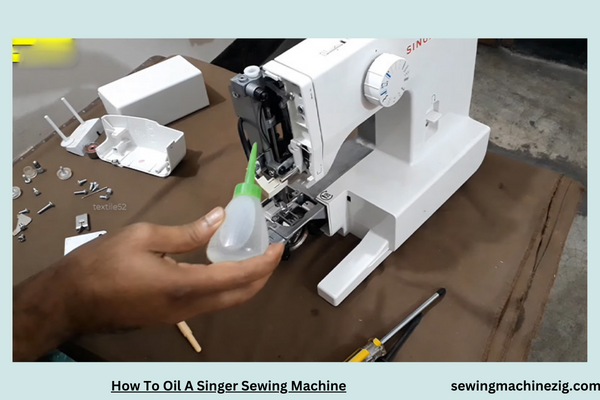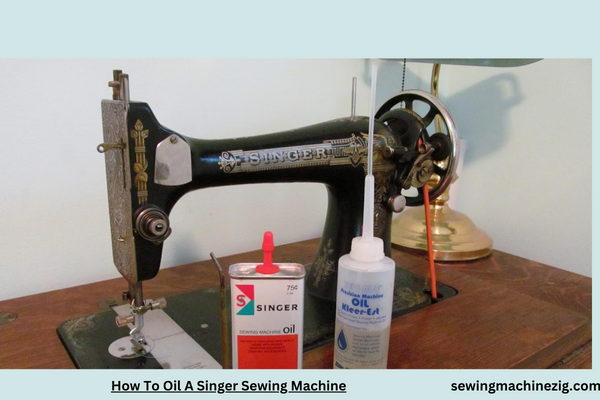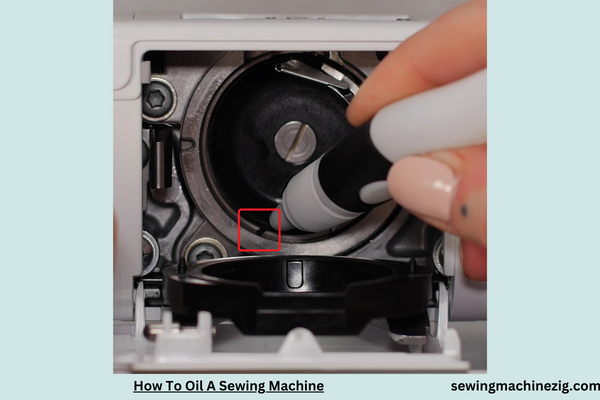
In the symphony of craftsmanship, a well-maintained sewing machine is the conductor orchestrating seamless stitches. Central to this performance is understanding How To Oil A Singer Sewing Machine. Regular lubrication is the lifeblood that sustains the machine’s longevity and functionality.
Nurturing your Singer sewing machine with the right oiling techniques is akin to bestowing it with vitality, ensuring smoother operation, and reducing wear. Join us on a journey through the art of maintenance, as we demystify the process of oiling a Singer sewing machine, safeguarding its precision and enhancing the melody of your creative endeavors.
How To Oil A Singer Sewing Machine Detailed Answer

As the backbone of your creative endeavors, a well-maintained sewing machine is essential for smooth and precise stitching.
In this comprehensive guide, we will unravel the steps on How To Oil A Singer Sewing Machine, ensuring its longevity and optimal performance for countless projects.
Step 1:
Gather Your Supplies Before you begin, gather the necessary supplies. You will need sewing machine oil specifically designed for Singer machines, a lint-free cloth, and your Singer sewing machine’s user manual for reference.
Step 2:
Identify Oiling Points Consult your Singer sewing machine’s manual to identify the specific points that require oiling. Typically, these points include the bobbin area, needle bar, presser foot, and other moving parts.
Step 3:
Prepare the Machine Switch off and unplug your Singer sewing machine to ensure safety during the oiling process. Raise the presser foot and needle to their highest positions, providing better access to the internal components.
Step 4:
Clean the Machine Before applying oil, use a lint-free cloth to clean any dust or debris from the identified oiling points. A clean machine ensures that the oil can penetrate and lubricate effectively.
Step 5:
Apply the Oil Dip the tip of the oil dispenser into the sewing machine oil. Apply a small drop of oil to each identified oiling point. Be conservative with the amount, as excess oil can attract more lint and dirt.
Step 6:
Distribute the Oil After applying oil, manually move any relevant parts to help distribute the oil evenly. For example, engage the handwheel to allow the oil to reach deeper into the machine’s mechanisms.
Step 7:
Wipe Excess Oil Use a lint-free cloth to wipe away any excess oil. This step is crucial to prevent oil from transferring onto fabric during your sewing projects.
Step 8:
Oil the Bobbin Case If your Singer sewing machine has a removable bobbin case, apply a small drop of oil to the specified points in the bobbin area. Ensure that the oil reaches the moving parts for optimal lubrication.
Step 9:
Run a Test Stitch After oiling, run a few test stitches on scrap fabric to help distribute the oil throughout the machine. This also ensures that any excess oil is expelled before working on your actual project.
Step 10:
Establish a Maintenance Schedule To keep your Singer sewing machine in top condition, establish a regular maintenance schedule. Depending on usage, aim to oil the machine every 8 to 10 hours of sewing or at least once a month.
Mastering How To Oil A Singer Sewing Machine is a key aspect of maintaining its longevity and performance.
By following these step-by-step instructions, you can nurture your sewing machine, ensuring it remains a reliable companion throughout your creative journey.
Remember, a well-oiled machine is not only a testament to craftsmanship but also an investment in countless seamless stitches.
How To Oil A Sewing Machine

In the realm of sewing, a well-oiled machine is synonymous with smooth stitches and lasting performance. This detailed guide unfolds the essential steps on how to oil a sewing machine, emphasizing the significance of regular maintenance for optimal functionality.
Step 1:
Assemble Your Supplies Begin by gathering the necessary supplies: sewing machine oil, a lint-free cloth, and your sewing machine’s manual. It’s crucial to use oil specifically designed for sewing machines to ensure compatibility.
Step 2:
Familiarize Yourself with Oiling Points Consult your sewing machine’s manual to identify the designated oiling points. Common areas include the bobbin case, needle bar, presser foot lever, and any other points specified by the manufacturer.
Step 3:
Prepare the Machine Prioritize safety by turning off and unplugging your sewing machine. Raise the needle to its highest position and lift the presser foot to facilitate easier access to internal components.
Step 4:
Clean the Machine Using a lint-free cloth, meticulously clean any accumulated dust or lint from the identified oiling points. A clean machine ensures that the oil can penetrate effectively and provide optimal lubrication.
Step 5:
Apply Small Drops of Oil Dip the tip of the oil dispenser into the sewing machine oil, then apply small drops to each identified oiling point. Exercise caution not to overapply, as excess oil can attract lint and debris.
Step 6:
Distribute the Oil To ensure even distribution, manually move relevant parts of the machine after oiling. Engage the handwheel or any movable components specified in your manual, allowing the oil to reach all necessary areas.
Step 7:
Wipe Away Excess Oil Use the lint-free cloth to wipe away any excess oil from the surface of the machine. This step is crucial to prevent oil transfer onto fabric during your sewing projects.
Step 8:
Oil the Bobbin Case If applicable, focus on oiling the bobbin case. Apply a small drop of oil to the designated points in this area, ensuring thorough lubrication for the rotating parts.
Step 9:
Run a Test Stitch After oiling, run a few test stitches on scrap fabric. This not only helps distribute the oil throughout the machine but also allows any excess oil to be expelled before starting your actual sewing project.
Step 10:
Establish a Routine Maintenance Schedule To uphold the longevity of your sewing machine, establish a routine maintenance schedule. Depending on usage, aim to oil the machine every 8 to 10 hours of sewing or at least once a month to ensure consistent performance.
Conclusion
In conclusion, learning how to oil a Singer sewing machine is more than a routine maintenance task; it’s a commitment to the longevity of your trusted companion. Regular oiling not only ensures the smooth operation of moving parts but also preserves the machine’s overall health.
As you cultivate this essential skill, your Singer sewing machine becomes a reliable partner, stitching through time with grace and precision. Embrace the ritual of oiling, and let your sewing machine hum with vitality, ready for countless creative endeavors.
FAQs: How To Oil A Singer Sewing Machine
Q1: Why is it essential to oil my Singer sewing machine?
A1: Oiling is crucial to prevent friction between moving parts, ensuring smooth operation, reducing wear and tear, and extending the lifespan of your Singer sewing machine.
Q2: How often should I oil my Singer sewing machine?
A2: Consult your Singer sewing machine manual for specific recommendations. Generally, oiling is recommended after every 8 to 10 hours of sewing or as indicated in your machine’s guidelines.
Q3: Can I use any oil for my Singer sewing machine?
A3: No, it’s important to use sewing machine oil or specifically formulated lubricants recommended by Singer. Avoid using household oils as they may damage your machine. “How To Oil A Singer Sewing Machine“
Q4: Where should I apply oil on my Singer sewing machine?
A4: Apply oil to designated points mentioned in your machine’s manual, typically on the shuttle hook, race, and other moving parts. Follow the manual’s illustrations for precise locations. “How To Oil A Singer Sewing Machine“
Q5: Can over-oiling my Singer sewing machine cause issues?
A5: Yes, over-oiling can attract lint and dust, leading to potential machine malfunctions. Follow the recommended oiling intervals and quantities specified in your Singer manual. “How To Oil A Singer Sewing Machine“
Q6: What if my Singer sewing machine manual is lost?
A6: Contact Singer customer support or visit their official website to obtain a digital copy of your machine’s manual. It contains crucial information on oiling and maintenance. “How To Oil A Singer Sewing Machine“



